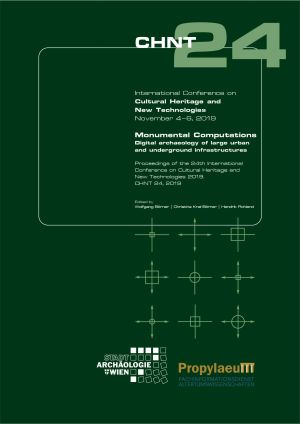
How to Cite
Museen der Stadt Wien - Stadtarchäologie (Ed.): Monumental Computations: Digital archaeology of large urban and underground infrastructures, Heidelberg: Propylaeum, 2021 (Proceedings of the International Conference on Cultural Heritage and New Technologies, Vienna, Volume 24). https://doi.org/10.11588/propylaeum.747
License

This work is licensed under a Creative Commons Attribution-NonCommercial-NoDerivatives 3.0 Unported License.
Published
06/10/2021
Downloads
Monumental Computations
Digital archaeology of large urban and underground infrastructures
The international conference "Cultural Heritage and New Technologies" took place in 2019 on the theme "Monumental Computations - Digital archaeology of large urban and underground infrastructures" at the Vienna City Hall.
The conference papers address the challenges of large urban development projects for the responsible organizers, whose goal is to preserve the cultural heritage of the cities concerned as much as possible. In this context, computer-based approaches are indispensable in all steps of a large urban development project.
Chapters
Table of Contents
Pages
PDF
Digital innovation within the UK’s largest archaeological projects
25-28
Photogrammetry, Georeferencing, Monitoring and Surveying
39
Resurrection of the Steppe Empires: Data Recording, Reconstruction and Semi-Automated Interpretation
Application and development of advanced visualisation and edge detection methods in the context of the Uyghur capital of the 9th century
41-52
Projection of 2D documentation drawings on a 3D SfM model
63-73
75-86
A very narrow artificial cave from the Middle Ages
87-91
A multidisciplinary approach to Khar Khul Khaany Balgas, Khanui River Valley, Mongolia
93-97
101
An evaluation of remote sensing techniques at the River Lugg, Herefordshire, UK
113-116
Automated anomaly-analysis of geomagnetic data using open-source GIS-tools
117-120
An overview on the national LiDAR support for the archaeological research on Mediterranean unfavourable areas
121-123
Virtual Reconstitutions as interpretations of knowledge
129-140
Quality Chart for Museum Photogrammetric 3D Asset
159-170
On the Gaming Industry’s Contribution to Archaeology and What We Can Contribute to the Gaming Industry
171-186
203-217
Results on Norwegian data
227-238
Combining LiDAR with land use models for automated detection approaches
239-243
251-254
A Case Study at Barber Temple Ruins in Bahrain
259-270
271-285
How we can use the molecular decay of wood for dating purposes
291-294
Photogrammetry and digital twin creation for an ancient urban physical model
299-311
Reconstructing the distribution of daylight in lost architecture
317-334
353-361
Facing modern challenges by integrating historical and present-day data on rural and urban infrastructure
377
A proposal for gamified immersive experiences of early watercraft and audience engagement
379-401
Bursa Forestry Museum (Saatçi Ali Pavilion) Conservation Problems and Suggetions
423-426
429
From Theory to Real: Conception, Project, and Realization of a Temporary Exhibition
431-441
475-478
Use of digital technologies in protest at the British Museum
487-489
An example of public participation and monument preservation in Austria
493-496
How we use augmented reality to revolutionize cultural mediation in Vienna’s city centre
501-504
Using Visitor Data and Analytics to Optimize the Design and Operations of Large and Complex Venues
509-512
Presenting a framework of visitor studies with a special focus on tracking & timing
513-518
Innovative solutions for sharing open archaeological data
529-532
Virtual reconstruction of a fragmented terracotta sculpture
551-554
A direct translation from verbal into visual architecture
555-559
Developing concepts to model archaeological data
573-577
591-594
Molecular analysis of black crusts deposits
605-609
Digital survey of ruins of Torre degli Embrici in Rionero in Vulture, Italy
621-623
629-632
Archaeological reconstructions based on 3D models created for documentation purposes by photogrammetry and CT scanning
633-636
The case of the double abandoned Silos in Livorno, Italy
651-654
A Common Digital Platform for Medieval and Early Modern Epigraphy
655-658






